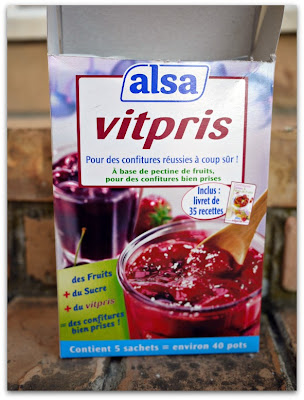If you've never made preserves before, there are a few products available in most French grocery stores that make it a synch.
Before I discovered them, I was a jam purist, using only sugar, high heat, and the natural pectin in fruits to obtain the proper consistency in my preserves. On a whim, I whipped up a batch of marmalade with one of them called Confisuc, and I've been using it ever since.
These specialized products are a combination of gelling agent and sugar and I think they make a better jam or jelly simply because they reduce the cooking time to mere minutes. With this short cooking time, the full, fresh, intense flavour of the fruit really stands out.
 French companies St Louis and Béghin Say, and German company Dr Oetker, each make products that are a combination of a gelling agent and sugar. All you need to do is add the correct amount of fruit and cook the mixture for a few minutes according to recipes that you'll find on their websites.
French companies St Louis and Béghin Say, and German company Dr Oetker, each make products that are a combination of a gelling agent and sugar. All you need to do is add the correct amount of fruit and cook the mixture for a few minutes according to recipes that you'll find on their websites.
St Louis makes 3 products under their special line called, Confisuc. Special Gellée is for making jelly, Special Abricots is for making Apricot jam and Special Confitures is for making jam with all other fruits. Each of these products is a combination of sugar and pectin as a gelling agent.
Dr Oetker makes 4 products. Two are a mixture of sugar and gelling agent: Fruttina Extra to make reduced sugar jams, and Fruttina Fraise, specially formulated for making strawberry jam. Their two other products are packets of gelling agents Gélfiant Priz Classique made with apple pectin and Gélfiant Priz Extra to make jams with a reduced amount of sugar.
The final product is Vitpris by Alsa which is a mixture of pectin, dextrose, and citric acid. It's basically the French version of the North American pectin products made by Certo or Bernardin. You can also use Vitpris to make pâtes de fruits so I always keep a box of it on hand in case I find something interesting at the market or in the garden. They also include a nifty little recipe book with each box.
Before I discovered them, I was a jam purist, using only sugar, high heat, and the natural pectin in fruits to obtain the proper consistency in my preserves. On a whim, I whipped up a batch of marmalade with one of them called Confisuc, and I've been using it ever since.
These specialized products are a combination of gelling agent and sugar and I think they make a better jam or jelly simply because they reduce the cooking time to mere minutes. With this short cooking time, the full, fresh, intense flavour of the fruit really stands out.
 French companies St Louis and Béghin Say, and German company Dr Oetker, each make products that are a combination of a gelling agent and sugar. All you need to do is add the correct amount of fruit and cook the mixture for a few minutes according to recipes that you'll find on their websites.
French companies St Louis and Béghin Say, and German company Dr Oetker, each make products that are a combination of a gelling agent and sugar. All you need to do is add the correct amount of fruit and cook the mixture for a few minutes according to recipes that you'll find on their websites. St Louis makes 3 products under their special line called, Confisuc. Special Gellée is for making jelly, Special Abricots is for making Apricot jam and Special Confitures is for making jam with all other fruits. Each of these products is a combination of sugar and pectin as a gelling agent.
Béghin Say has three products under their Special Confitures label, two are for making jellies, one with white sugar and one with brown, and a third, Allégées, is specially formulated so you can reduce the amount of sugar you use by 30%. They also have a great web site with recipes for almost every fruit imaginable.
Dr Oetker makes 4 products. Two are a mixture of sugar and gelling agent: Fruttina Extra to make reduced sugar jams, and Fruttina Fraise, specially formulated for making strawberry jam. Their two other products are packets of gelling agents Gélfiant Priz Classique made with apple pectin and Gélfiant Priz Extra to make jams with a reduced amount of sugar.
The final product is Vitpris by Alsa which is a mixture of pectin, dextrose, and citric acid. It's basically the French version of the North American pectin products made by Certo or Bernardin. You can also use Vitpris to make pâtes de fruits so I always keep a box of it on hand in case I find something interesting at the market or in the garden. They also include a nifty little recipe book with each box.

Now that you've found some great fruit, bought your jelling product and have your croissants all ready to go, you'll need some jars. I always buy mine in Italy at the Supermercato Conad in Latte. They sell pretty Bormioli Rocco Quattre Stagioni preserving jars in different sizes and at a good price to boot!
With spring finally here and so many fabulous fruits on the way, why not whip up a few jars of home made jam to slather on your morning baguette and share with friends?
Give it a go!










































